Cabbage
Local language: kabich-Luo. Cabbages is a biennial crop, grown as an annual crop, it has round dense leaved head. The leaves are green, white or red with short stem and fibrous roots. Cabbages are mainly used as a vegetable in main dishes and in various salads. It is sometimes used as livestock feed.
Nutritionally cabbage has Vitamins A, C & K, fiber, folate and potassium. The antioxidant components suppress cancer cell growth.
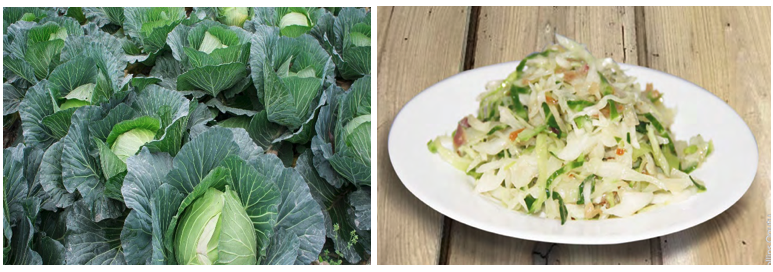
Cabbage
Varieties
Riana F1
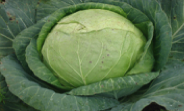
Source:InfonetBiovision.Org
- Matures after 85-90. days.
- Average Weight per head is 6 Kg
- Its tolerance to black rot disease
- Yields 120 t/ha, Compact head and good shelf life
Gloria F1
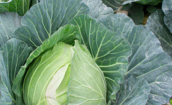
Source: Infonet Biovision.Org
- Matures after 80-85 days
- Average head weight is 5Kg.
- Yields 100 t/ha
- Tolerates transportation and Long shelf life
Pruktor

- Matures after 80-90 days.
- Its average head weight is 4-6 Kg.
- Yields 95 t/ha
- Highly tolerant to black rot and ring spot
- Compact head, pleasant taste
- Compact head, pleasant taste
Other Varieties
- Copenhagen large Market (Heat tolerant)
- Pretoria F1(Heat tolerant variety)
- Fiona F1(Heat tolerant and early maturing variety
- Typhoon F1 (Heat tolerant)
- Chinese cabbage (Early maturity)
- Green Challenger F1 (Early Maturing)
- Bakara F1
- Blue Dynasty
- Golden Acre
Ruby Perfection F1 (Cold and hot temperature tolerant).
Select a site for cabbage production with:
- Well-drained soil, rich in organic matter and sufficient moisture and pH of 6.0 – 6.5.
Ecological requirements
Cabbage requires Altitude: – 800 – 2000 m.a.s.l.
Temperature: 4 – 24oC is required for optimal growth.
Rainfall: A well-distributed rainfall of between 380 – 500 mm
Land Preparation
- Till the land before planting and before onset of rain.
- Land preparation during wet-period prevent unintended spread of soil borne diseases.
- It is advisable to carry out soil analysis to ensure optimum fertilizer application.
- Add manure and fertilizer with recommendations from soil testing results.
Nursery Establishment
Ensure cabbage nursery has fine soil free of stones, soil crumbs, roots, plastics etc.
Beds width of 1 meter and a convenient length not exceeding 100 meters and a height of 15 centimeters.
Row spacing should be at least 15 cm.
The furrow seed sowing should be 1-2 cm deep.
DAP is applied at a rate of 50gms/m2 or use any other compound fertilizer as per soil analysis results.
Seed should be dusted with a fungicide and insecticide to protect seeds from pest and diseases
Cover the seed lightly with a 1cm layer of fine soil, water, cover with straw or dry grass well.
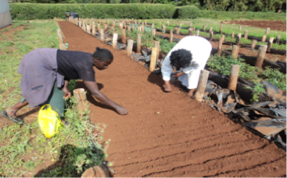
- Seedlings are ready for transplanting after 4-6 weeks in the nursery depending on temperatures.
- Planting should be done either in the early morning or late afternoon when the soils are cool and wet.
- Proper seed-soil contact is especially important for direct seeded crops.
- Wet the seedlings an hour before transplanting.
- Plant at the onset of rains with a spacing of 60x60cm for large headed cabbage varieties, 60x45cm for medium-sized varieties and 30x30cm for small headed varieties.
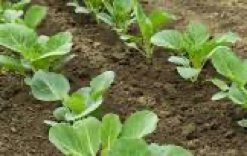
- Irrigate the cabbage crop when necessary.
- Water requirements vary from 380 to 500mm depending on climate and the length of growing season.
- It is important to keep the soil moist but not soggy as cabbages cannot tolerate water logging.
- When growing cabbage in the field. You can use sprinkler or drip irrigation systems in order to keep soil constantly moist.
- Apply a thin layer of mulch (straw, leaves, crop residues, green manure crops, or saw-dust, stones or plastic planes etc.).

- Keep the fields weeds free. Weeds are potential host of pests and disease and also nutrient competitors for cabbage plant.
- Proper weed control is very essential for improved quality and quantity produce.
- Weeds in and around the field can harbor insects and disease pathogens that can invade or spread to the crop soon after planting.
- Control weed from early stages of cabbage growth to avoid direct competition for nutrients, water and light.
- Test soils before planting to guide application rates of manure and fertilizer, soil test is recommended for accurate fertilization.
- Cabbages are heavy feeders and require N: P: K ratio of 1; 1:1 (which can be commonly found as 10:10:10 or 12:12:12) which are amounts of nitrogen Phosphorus and potassium respectively.
- Cabbage is moderately sensitive to salinity and yield decrease when the soil is salinity.
- Cabbage does well when soils are enriched with organic compost incorporate
- Avoid applying fresh manure to cabbage, since it causes death of roots and pests that attack the root system.
- Observe the farm regularly during crop production period for Pests, disease, weeds and general look of crop health like water and nutrition requirement.
- Practicing conservation tillage is recommended for moisture conservation and to reduce field operations by farm equipment thus reducing soil compaction.
- In disease management crop residues should be removed from the field and destroyed or deeply ploughed in to reduce sources of disease infection and spread.
- Mulch around cabbage to preserve soil moisture and keep the soil cool in warm weather.
- Intercrop to reduce pest infestation.
- Check field regularly for pest and disease occurrence.
Monitor cabbages regularly for pest and disease occurrence. Early detection of pests and diseases is critical to easier control of outbreaks.
Diamond Black Moth
Source: Infonet Biovision.Org
- The DBM moth is grey in colour. When it closes its wings, a diamond pattern can be seen at the back.
Control
- Use of pesticides, either chemical ones or bio pesticides.
- Use of neem-based insecticides (insecticides that are extracted from neem leaves and seeds).
- Intercropping cabbages with tomatoes, beans and onions If intercropping with tomatoes, the tomatoes should be planted 30 days before the cabbages are planted.
The Sawfly
Source: Infonet Biovision.Org
- The larvae of the sawfly are what causes damage to cabbage.
- The sawfly larva is grey in color, resembling a caterpillar and feeds on the leaves of cabbages, leaving only the vein.
Control
- Removal of any wild host plants that belong to the cabbage family, removal of the larvae by hand and use of both organic and chemical pesticides.
Aphids
Source: Infonet Biovision.Org
- Aphids damage cabbage by sucking sap from the plant, leaving the leaves curled and resulting in the poor formation of cabbage heads.
- There are three types of aphids that affect cabbages. These are: -
- Green Peach Aphid
- Mealy Cabbage Aphid
- False Cabbage Aphid.
Control
- Use pesticides and insecticides to control aphids on your cabbages.
Slugs
Source: Infonet Biovision.Org
- Slugs hide under the cabbage leaves, eating the leaves. This affects the quality of cabbages harvested.
- The slugs in cabbages can be controlled by drowning them. Dig in tins in the field. Fill in the tins with water and add yeast to attract the slugs. The slugs will then drown in the water.
Cutworms
Source: Infonet Biovision.Org
- Cutworms are blackish-grey larva that hide in the soil around cabbages. They will come out at night to eat your cabbage stems, then hide during the day.
- Cutworms affect cabbages by chewing the cabbage stems partially or completely. This will make the cabbage plant fall.
- Intercropping the cabbage fields with garlic will not only keep away the pests from attacking the cabbage crop but will also enable the farmer earn an extra income from the sale of the cabbages or garlic.
Club Root
Source: Infonet Biovision.Org
- Club roots in cabbages lead to swelling of the roots. They develop galls and the shape of the roots is distorted. It is caused by a fungus. The swollen roots are then infected by bacteria leading to rotting.
Control Practice crop rotation, destroy infected plants. Apply lime to the soil. This creates an environment that is not favorable to club root.
Bacterial Soft Rot
Source: Infonet Biovision.Org
- Bacterial soft rot in cabbages is a soil-borne disease that spreads quickly when water splashes from leaf to leaf.
- After harvest, the cabbage heads soften and then rot, developing a very bad smell.
Control:
- Do crop rotation with cereals and legumes.
- Maintain proper field hygiene and do not harvest when it is wet.
- Destroy infected plants.
- Harvested cabbages should be handled and stored well.
- Use copper-based fungicide when the heads begin to form.
Alternaria Leaf Spot
Source: Infonet Biovision.Org
- Alternaria Leaf Spot in Cabbages is caused by fungi. It is displayed by circular spots on the surface of older leaves, which enlarge into concentric rings with yellow borders. The infected area falls off leaving a hole.
- In harvested cabbages, the spots enlarge and may give way to soft rot bacteria, leading to bacteria soft rot as described above.
Control:
- Use clean planting material that is free of disease and practice crop rotation.
- Any infected plants should be destroyed.
Ring Spot
Source: Infonet Biovision.Org
- Ring spot is a seed-borne disease that can come from the use of infected seeds.
- In cabbages its spread by wind and also spread by using compost that was made using infected plant remains.
- Ring spot in cabbages is shown by brown-grey spots on leaves with a green border and blackish inner zones.
Control
- Use clean seeds.
- Practice crop rotation, where you should not plant a crop from the same family for at least 2 years.
- Maintain good field hygiene.
- You can also use fungicides.
Black Leg
Source: Infonet Biovision.Org
- Blackleg, also known as dry root canker is a seed-borne disease, spread by crop remains, infected seeds and tools.
- Infected cabbages will dry suddenly or fall over as the cabbage head becomes heavier.
- The cabbage leaves will have light brown spots.
- The spots on the leaves eventually develop grey centers with many black spots.
- The cabbage stems develop cankers (damage to the stems) that move to the roots, killing them.
Control:
- Use clean seeds that are free from disease.
- Practice good field hygiene and crop rotation.
- The soil should have good drainage.
- Plants that have black leg should not be used as animal feed, as the manure from the animals will carry the disease.
Black Rot
Source: Infonet Biovision.Org
- Black rot is caused by bacteria
- The disease shows V-shaped brown lesions on the leaf.
- The veins turn black.
- A black ring is seen on the stem when cut across. Infected cabbage heads eventually become soft and turn black, they rot and produce a very bad smell.
- Black rot spreads mostly when temperatures are hot and when the environment is wet.
Control:
- use clean seeds and destroy plant remains by fire.
- Rotate your crops for 3 years.
Damping Off
Source: Infonet Biovision.Org
- As a common disease in cabbages, damping off is a fungal disease that affects cabbages mostly in the nursery.
- The cabbage seedlings rot at the bottom of the stem, eventually collapsing. It affects cabbage seedlings mostly during the rains as a lot of moisture creates the perfect condition for damping off.
Control:
- Do not plant your cabbage seedlings where there has been an infestation of the disease before. Make sure the soil does not have too much moisture.
- Space the cabbage seedlings well so as to allow the soil to dry, in case of excess moisture.
- Cabbage matures after 3 to 4 months.
- A mature cabbage has a well-developed head and good weight in comparison to its size. Mature cabbage has a longer postharvest life than immature cabbage.
- You will be able to tell that the cabbage is mature when the head becomes solid.
- They will feel firm when squeezed.
- You have to harvest them at this point, or else they will start splitting.
Mature cabbage
- The time for harvesting cabbage depends on the variety and ecological region. Use a sharp knife to harvest cabbages.
- Timely harvesting is required, when the heads are firm before they start cracking. The heads should be cut at the base, with the outer leaves that will protect it and keep it fresh during transport and in the market. Injuring the head will lead to rotting.
- With good management practices, your cabbages will yield between 15 tonnes to 70 tonnes per acre, depending on the variety.
- To prevent bacterial soft rot in cabbages, avoid harvesting in warm, moist weather. Harvest cabbages while the heads are cool & dry.
- After harvesting cabbages, practice field sanitation by removing crop residues & weeds immediately after harvesting to control pests & diseases.
- Store Cabbage in a cool and airy place. If you store cabbage in a cool dry place, the cabbages can keep for 2 to 3 weeks.
- Do not store in air tight bags as this causes rotting.
- Harvested cabbage is at risk of wilting. Remove from field & direct sunlight and take to a well aerated shaded area for packing and transport to market
- Cabbages are sorted, where the ones with diseases or damages are put aside and the
- rest taken to market.
The grading for cabbages is a follow: -
- Small cabbages will weigh between one and two kilograms.
- Medium cabbages will weigh between three and four kilograms.
- Large cabbages will weigh over five kilograms.
- In the market, cabbages are sold at different prices, depending on the grade.
- Source for Cabbage market prior to harvesting. Cabbage is easily available in most local market in the country,
- It is best recommended to sell cabbage straight from the farm to market while it is still fresh.
- Prices are affected by demand and supply forces.
Garden pea planter/seed drill - a farm implements that sow seeds at a desired seeding rate and depth, ensuring that the seeds are covered and compacted under soil.
Motorized Knapsack Sprayer – a farm implement used in chemical application.
Land preparation
Laying of drip irrigation pipes
- Cabbages are mainly used as a vegetable in main dishes and in various salads.
- It is sometimes used as livestock feed.
- Nutritionally cabbage has Vitamins A, C & K, fiber, folate and potassium.
- The antioxidant components suppress cancer cell growth.
Ingredients
- Cabbage
- ½ onion
- ½ cup (83 g) cooking oil
- 2 ½ tsp. (12 g) salt, iodized
Preparation 10 minutes
- Prepare and cut the onions and the cabbage into separate bowls.
- Add the cooking oil into a cooking pot over fire and then put the chopped onions.
- Stir the onion and cook for 2 minutes.
- Add the cabbage and stir.
- Add salt and continue to stir the cabbage to cook it evenly.
- Cook for an additional 5 minutes.
- Remove and serve.
Basic costs (variable costs) KES 80,000/acre
- Estimated returns (gross margin) KES 190,000/acre
- However, the gross margin will largely depend on the variety grown, the level of
- management employed by the farmer and prevailing market situation.
https://www.greenlife.co.ke/cabbage-planting-guide/
https://infonet-biovision.org/PlantHealth/Crops/CabbageKale-Brassicas
Contacts
Kenya Agricultural and Livestock Research Organization
P.O. Box 57811-00200, Nairobi, Kenya
Call: 0111010100